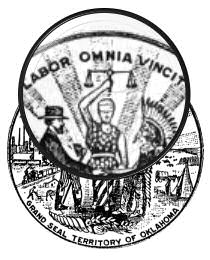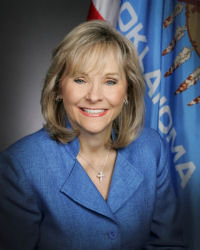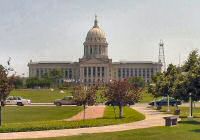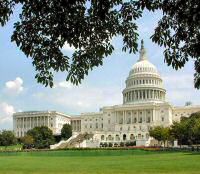|
STATEHOOD:The land called Oklahoma was purchased from France, in 1803, as part of the
Louisiana Purchase. From 1803 to 1819, Oklahoma was part of several territorial districts as the United
States reorganized its land holdings due to boundary disputes and treaties. By 1819, Oklahoma, minus
the panhandle, was part of the Arkansas Territory.
In the early 1800's, there was intense pressure to remove Indians from the settled
east. In response, the U.S. Government reserved Oklahoma for Native Americans and, in 1828, required
all settlers to withdrawn from the area. Between 1830 and 1842, a sad chapter of U.S. history, the
Cherokee, Chickasaw, Choctaw, Creek, and Seminole Indians
(The Five Civilized Tribes)
were compelled to give up their homelands and move to Oklahoma. The Cherokee people referred to this
migration as the "Trail
of Tears."
Soon, settlers looking for more property and the railroads looking for revenue coveted the
reserved Indian Territory. By the late 1880s, Native Americans were pressured again as Indian Territory
was divided into two parts. In 1889, the western half of Indian Territory, including the panhandle,
was opened for settlement. On March 2, 1890 this land, plus an additional 3,681,000 acres, was established as
Oklahoma Territory by the U.S. Congress and Guthrie was designated as the Territorial Capital.
Demands for Indian land continued and the Dawes Commission was formed to bargain with the
Indians for their land and to dissolve the Indian nations.
In 1905, leaders of the Five Civilized Tribes formed a constitutional convention in Muskogee,
inviting settlers to participate. The convention adopted a constitution for a state, called Sequoyah,
and voters approved it. The United States Congress was unwilling to accept Indian Territory as a
separate state however. Congress wanted
Indian Territory and Oklahoma Territory
combined into one state. In 1906, representatives from Indian Territory and Oklahoma Territory met in
Guthrie to draw up a new constitution that would combine the two territories as one new state.
On November 16, 1907, Oklahoma was admitted to the union. The state capital, Guthrie, was
moved to Oklahoma City in 1910. |
| |
|
STATE CONSTITUTION:A constitution sets out the rules by which we play the game
of government. Like the rules for any other game, it limits the moves available to players. It describes how
the various players interact with each other, and who has more power in various situations.
A constitutional convention assembled in Guthrie, Oklahoma on November 20, 1906 and worked
until July 6, 1907 developing the Constitution of the State of Oklahoma. It was approved by Oklahoma
voters on September 17,1907 and went into effect on November 16, 1907 when Oklahoma became the 46th state to be
admitted to the Union.
Amendments (changes) to the Oklahoma Constitution may be proposed in either the House of Representatives
or the Senate. If an amendment is agreed to by a majority of the member of each house of the Legislature,
the amendment is presented to the citizens of Oklahoma for their vote. If a majority of voters approve
an amendment, it becomes part of the Oklahoma Constitution.
The Legislature may also propose that a constitutional convention be held to amend the Oklahoma
Constitution. But a proposal for a convention must be approved by a majority of the voters before
it may be held.
As designated by the Oklahoma Bill of Rights, voters may also petition (make a formal written
request) the government to begin formal proceedings on a proposed amendment.
PREAMBLE:Invoking the guidance of Almighty God, in order to secure and
perpetuate the blessing of liberty; to secure just and rightful government; to promote our mutual welfare
and happiness, we, the people of the State of Oklahoma, do ordain and establish this Constitution.
[ OKLAHOMA CONSTITUTION ] |
| |
|
STATE MOTTO:Oklahoma's motto is the Latin phrase, Labor Omnia Vincit. It dates
back over 2,000 years to the writing of a Roman poet named Virgil.
Virgil's phrase, Labor omnis vicit, is found in the first of a series of four Latin Poems,
Georgics. These poems were written in support of Augustus Caesar's "Back to the Land" campaign
to encourage more Romans to take up farming. The phrase is found in a section of the poem describing
the growth of agriculture from primitive beginnings.
 |
| Grand Seal Territory of Oklahoma |
Translated as "Labor Conquers All Things," by the state of Oklahoma, the phrase was incorporated
into the design of the Grand Seal of the Territory of Oklahoma during the second session of the
Territorial Legislative Assembly held in Guthrie, January 1893. This is shown, magnified, to the left
on the territorial seal. The phrase was later specified as a feature of the Great Seal of the State
of Oklahoma in the 1907 Oklahoma Constitution.
[ DESCRIPTION OF THE SEAL - OKLAHOMA CONSTITUTION ] |
| |
|
STATE GOVERNMENT:As in the case of the federal government, Oklahoma's state government is
organized into three branches - executive, legislative, and judicial. The state government is a product of
three documents: the United States Constitution, the Oklahoma State Constitution, and laws of the state.
The Governor of Oklahoma is the chief executive officer of the state, is elected for a
four-year term, and may serve an unlimited number of terms but not more than eight years in a row.
He or she is responsible for appointing certain state officers, veto or approval of bills
passed by the Legislature, granting pardons and paroles, calling special sessions of the legislature,
and commands the state militia. The Governor is also responsible for the preparation of the state budget
and ensures that all laws are obeyed in the state.
The Oklahoma State Legislature is the lawmaking branch of the state government. The
Legislature has the authority to pass laws that people must obey. The Legislature is also responsible
for raising and distributing the money necessary to run the state government.
The judicial branch of the Oklahoma Government interprets the laws. The Oklahoma Court System
is made up of the Supreme Court,
the Court of Criminal Appeals, the
Court of Civil Appeals,
and 77 District
Courts. Unlike most states, Oklahoma has two courts of last resort. The Supreme Court determines
all issues of a civil nature, and the Oklahoma Court of Criminal Appeals decides all criminal matters.
Members of these courts, and of the Court of Civil Appeals, are appointed by the governor from a list of
three names submitted by the Oklahoma Judicial Nominating Commission.
[ BRANCHES OF OKLAHOMA GOVERNMENT ]
As defined by the Oklahoma Constitution:
[ EXECUTIVE DEPARTMENT ]
[ LEGISLATIVE DEPARTMENT ]
[ JUDICIAL DEPARTMENT ]
[ GREAT SEAL OF OKLAHOMA ]
[ OKLAHOMA STATE FLAG ] |
| |
 |
Governor Mary Fallin
Courtesy of the
State of Oklahoma |
GOVERNOR:Mary Fallin (Republican)
FIRST GENTLEMAN:Wade Christensen
[ GOVERNOR'S PAGE ]
[ FORMER STATE GOVERNORS ]
[ GOVERNOR'S MANSION ]
[ TOUR INFORMATION ] |
| |

Oklahoma State Capitol Building
[ ABOUT ]
[ HISTORY ]
[ GREAT HISTORICAL TOUR ] |
OKLAHOMA CAPITOL BUILDING:
Location:Oklahoma City
Date Erected:1915-1917
Dome:2001-2002
- The Oklahoma capitol was designed, classic Greco-Roman, by English architects
Wemyss Smith and Solomon A. Layton in 1914.
- Ground was broken for the capital building on June 10, 1914 by Governor Lee Cruce.
Over 5,000 people in attendance.
- Construction began on August 4, 1915.
- The exterior is Indiana limestone and the base is Oklahoma pink granite from Troy, Oklahoma.
- The outside steps and tables are made of black granite from Cold Springs, Oklahoma.
- Floors are Alabama marble and the stairs and wall bases are Vermont marble.
- The capital building opened on June 30, 1917 without the dome that was included in the design.
A temporary "saucer dome" was built to close the building.
- With no dome, the capitol was nicknamed "Old Baldy."
- 85 years after the capitol was opened for business, a capitol dome was dedicated on Oklahoma
statehood day, November 16, 2002.
- Many portions of the temporary dome were saved as historic artifacts including the stained glass
skylight, plaster crown, and cut limestone.
- The Oklahoma Capitol is surrounded by working oil wells. The well in front of the
entrance is nicknamed "Petunia #1" because the drilling began in the middle of a flower bed.
- The 6,000 pound, 22-foot tall, bronze Native American warrior that stands on top of the capitol dome
is called "The Guardian." It was sculpted by State Senator Enoch Kelly Haney, an American Indian
of Seminole and Creek descent whose family followed the Trail of Tears to Oklahoma seven
generations ago. It's the first statue representing Native Americans to be placed on top of a
state capitol.
- Four large portraits hang in the capitol's the rotunda:
- Robert S. Kerr, co-founder of the Kerr-McGee Oil Company, the 12th governor of Oklahoma, and
former U.S. senator;
- Sequoyah, inventor of the Cherokee syllabary;
- Will Rogers, goodwill ambassador to the world in his day;
- 1912 Olympic champion Jim Thorpe, who was a member of the Sac and Fox tribe.
|
| |
|
STATE REPRESENTATION:The Oklahoma Legislature is divided into two parts,
referred to as houses or chambers. The two houses are the Senate and the House of Representatives.
A legislature with two houses is called a bicameral body. The Latin roots of the word bicameral, "bi"
and "cameral," mean two chambers or rooms. There are 48 senators serving in the Oklahoma Senate and 101
representatives serving in the Oklahoma House of Representatives.
[ OKLAHOMA LEGISLATURE ] |
| STATE REPRESENTATIVES:Representatives in Oklahoma each represent
people in a specific area of the state. These areas are called house districts. There are currently 101 men
and women representing 101 house districts in the Oklahoma House of Representatives. 48 representatives are
Republicans and 53 are Democrats. Each representative serves for a period of two years in the House of
Representatives, after which he or she must run for re-election. A representative may not serve for more
than a total of 12 years, or six terms.
[ STATE REPRESENTATIVES ]
[ LEGISLATIVE DISTRICTS ]
[ FIND YOUR REPRESENTATIVE ] |
STATE SENATORS:Senators in Oklahoma each represent people
in a specific area of the state. These areas are called senate districts. There are currently 48 men and
women representing 48 senate districts in the Oklahoma Senate. 20 representatives are Republicans and 28 are
Democrats. Each senator serves for a period of four years in the Senate, after which he or she must run for
re-election. A senator may not serve for more than a total of 12 years, or three terms.
[ STATE SENATORS ]
[ LEGISLATIVE DISTRICTS ]
[ FIND YOUR SENATOR ] |
|
| |
|
LEGISLATIVE PROCESS:The legislative branch of government is responsible for making and
maintaining laws within their jurisdiction. United States representatives and senators, federal legislators,
are responsible for laws at the national level and state legislators are responsible for laws at the state
level. A law begins as an idea that is introduced in the Oklahoma Legislature as a bill by one or more
legislators. The bill then goes through the legislative process to become a law. During this process the bill
may be changed. Not all bills become law.
[ HOW A BILL BECOMES LAW IN OKLAHOMA ]
[ SENTATE LEGISLATIVE TERMS ]
[ HOUSE LEGISLATIVE TERMS ] |
| |
| CURRENT LEGISLATION:When the legislature is meeting, it is said
to be "in session." Regular sessions of the Oklahoma Legislature meet once a year, beginning at noon on the
first Monday in February. Regular sessions must be adjourned (ended) by 5 p.m. on the last Friday in May.
Normally, the Legislature is in session Monday through Thursday.
In odd-numbered years, the regular session will also meet at 12:00 noon on the first Tuesday after
the first Monday in January. This session will be adjourned (end) no later than five p.m. on the same day to
declare elections. Extraordinary sessions may be called by the Governor or by the Legislature itself.
The following link will allow you to look at bills that are currently going through the legislative process.
[ CURRENT LEGISLATION ] |
| |
| STATUTES:The following link will allow you to look at
Oklahoma's current laws.
[ OKLAHOMA STATUTES ] |
| |
| COUNTIES:The United States Constitution does not define local government.
Instead, this function is left up to the states.
Counties are a local unit of government within a state. All but two of the states are divided into
counties. Alaska is divided into boroughs and census districts and Louisiana is divided into parishes where
governing responsibilities are similar to counties.
Traditionally, counties performed tasks mandated by the state, such as property assessment, property and vital
statistic record keeping, maintenance of rural roads, administration of local election and judicial functions,
and support of the poor. Today, counties may be responsible for these functions, more or less, but the
responsibilities of county governments vary from state to state.
| COUNTY TRIVIA:
- There are 77 counties in Oklahoma.
- The largest county, at 2,251 square miles, is Osage County.
- The smallest county, at 371 square miles, is Marshall County.
- The greatest number of people live in Oklahoma County; 660,448 according to the 2000 census.
- The fewest people live in Cimarron County; 3,148 according to the 2000 census.
[ ABOUT COUNTY GOVERNMENT ]
[ OKLAHOMA COUNTY GOVERNMENT ]
[ ASSOCIATION OF U.S. COUNTIES ]
[ US CENSUS BUREAU ]
[ STATE MAPS ] |
|
| |
 |
United States Capitol Building
Washington, DC |
U.S. CONGRESSIONAL DELEGATION:
The legislative branch of the United States government makes laws for our nation and raises and distributes
money to run the United States government. The most evident part of the legislative branch is the United
States Congress. Congress is divided into two parts, called houses. The two parts are the Senate and the House
of Representatives. Congress is referred to as a bicameral body because it is made up of two houses. The Latin
roots of the word bicameral, "bi" and "cameral," mean two chambers or rooms. Members of the Senate are called
Senators and members of the House of Representatives are called Representatives. Senators and representatives
serving in these two bodies are sometimes referred to as congressmen, or women, and sometimes as legislators
because their business is to legislate or make laws. The role of the legislative branch is defined in the
United States Constitution.
[ THE UNITED STATES CONSTITUTION ]
Each state elects people to represent them in the United States Congress in Washington, DC. The citizens of each
state elect two senators to represent them in the Senate. They also elect representatives to represent them in
the House of Representatives. The number of representatives each state sends to the House of Representatives
is not a specific number like the Senate, but is based on the population of the state. The people, that are
elected to represent the state's citizens in the United States Congress, are referred to as the congressional
delegation.
There are 100 senators in the U.S. Senate. Each is elected to a term, in the Senate, of six years. There are 435
representatives in the U.S. House of Representatives. Each is elected to a term, in the "House," of two
years.
The citizens of Oklahoma elect two people, like every other state, to represent them in the Senate
and five people, based on Oklahoma's population, to represent them in the House of Representatives.
|
| |
|
broken links to us. We really appreciate it. |
Source: State of Oklahoma Web Site, (http://www.state.ok.us), May 13, 2004
Source: Office of the Governor of Oklahoma, (http://www.governor.state.ok.us/index.php), May 13, 2004
Source: Oklahoma Legislature, (http://www.lsb.state.ok.us/), May 13, 2004
Source: National Governor's Association, (http://nga.org), May 13, 2004
Source: The Catholic Encyclopedia, (http://www.newadvent.org/cathen/11230c.htm), May 14, 2004 |

 |
|
|
[ HOME
|| INTRO
|| SYMBOLS
|| ALMANAC
|| ECONOMY
|| GEOGRAPHY
|| STATE MAPS
|| PEOPLE
|| GOVERNMENT
]
[ FORUM
|| NEWS
|| COOL SCHOOLS
|| STATE QUIZ
|| BOOK STORE
|| MARKETPLACE
|| STATE LINKS
]
|| GUESTBOOK
|| CONTACT US
|| PRIVACY STATEMENT
] |
Site designed exclusively for NETSTATE.COM by NSTATE

NETSTATE.COM is a Trademark of NSTATE, LLC.
Copyright © 2004- by NSTATE, LLC. All rights reserved.
No copyright is claimed on non-original or licensed material.
Support NETSTATE
Top |
|



